Fall-Apart Roasted Pork Shoulder with Rosemary, Mustard and Garlic
on Oct 18, 2019, Updated May 13, 2021
This post may contain affiliate links. Please read our disclosure policy.
A super tender slow cooked marinated pork shoulder or butt roast recipe that is amazing on its own, and also can be used in so many ways. One of my go-to dishes for casual crowd entertaining.
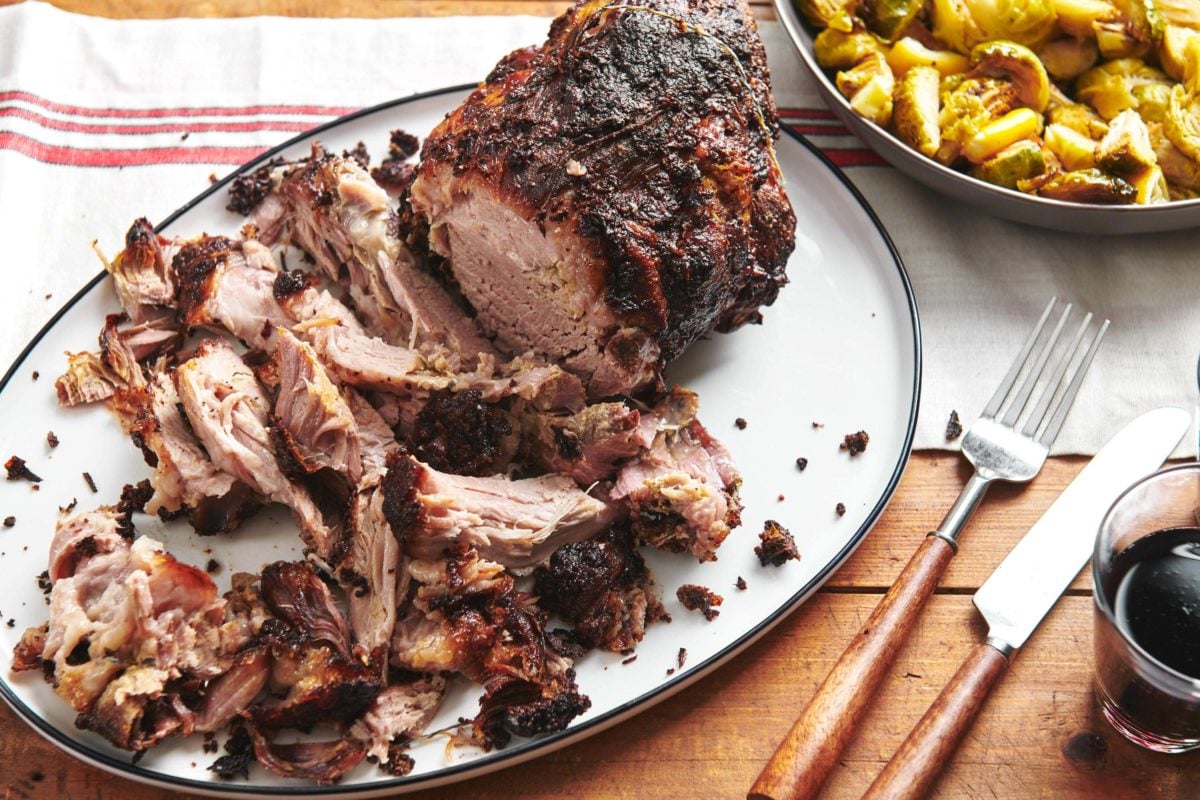
Best Pork Shoulder Roast
I was talking with my friend Chris about perfect meals for entertaining, and we went though the usual suspects: lasagnas, chili, tenderloins, and then he mentioned to me that his favorite go-to entertaining dish was a pork butt or shoulder. We talked about the best way to cook a pork shoulder roast: basically just letting it slow cook in the oven for ages at a very low temperature so that it practically falls apart.
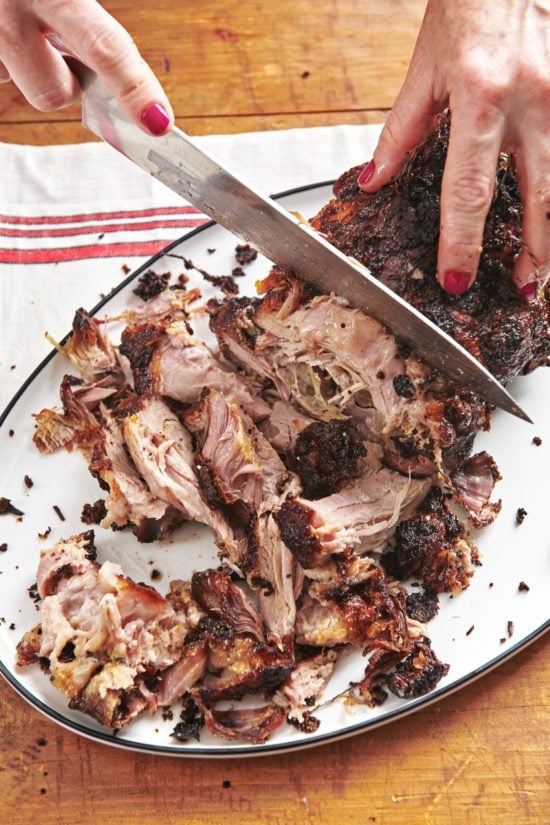
How to Cook Pork Shoulder Roast
Chris told me that long ago a chef has explained to him that meat likes to be cooked at around the temperature that it reached when it is done.
While I don’t think that is always the case at all (flame kissed steaks and burgers anyone?), it made nice sense when I thought about it in terms of a big tough hunk of meat, like this boneless pork shoulder roast, which needs low and slow cooking to make it turn from impossibly tough to tender. No amount of trying to rush the process will help, you’ve got to keep the heat low and the time long.
Pork Butt Roast
You can also make this recipe and others like it with a pork butt roast or Boston Butt pork roast, which are actually also from the shoulder area, a little further up, but essentially a similar cut of meat.
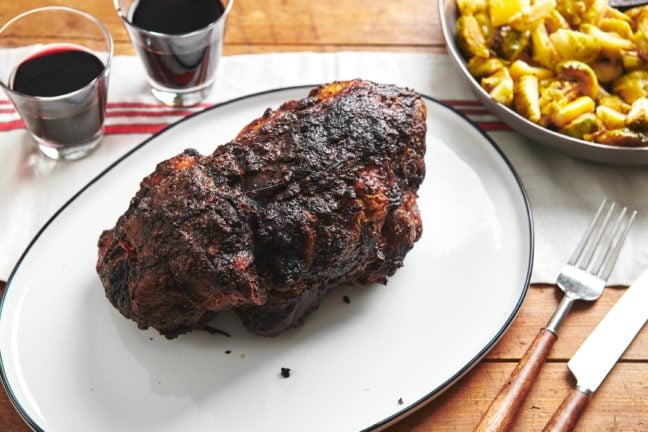
Slow Cooking Pork in Oven
When you slow cook pork shoulder in the oven, boneless or bone-in, you have a lot of flexibility, which is a delightful thing when entertaining. In fact, the cooking time at this low temp could be stretched by an hour or two, and the roast wouldn’t be any worse for the wear. So you can literally plunk it on the table whenever everyone is ready to eat.
Fat Side Down or Up?
And even though this recipe calls for boneless pork shoulder, which is a bit easier to cut, you can use bone-in pork shoulder which will cook in about the same amount of time. The instructions call for the fat side to be down in the pan, which give the top the chance to get a nice crust, but it really doesn’t matter. Some people like the fat on the top, which kind of bastes the pork as it cooks, but then you have less crusty surface. Your call, you won’t go wrong.
The best part? This is free time you can spend reading, dancing, sleeping, cleaning a closet, saving kittens from trees.
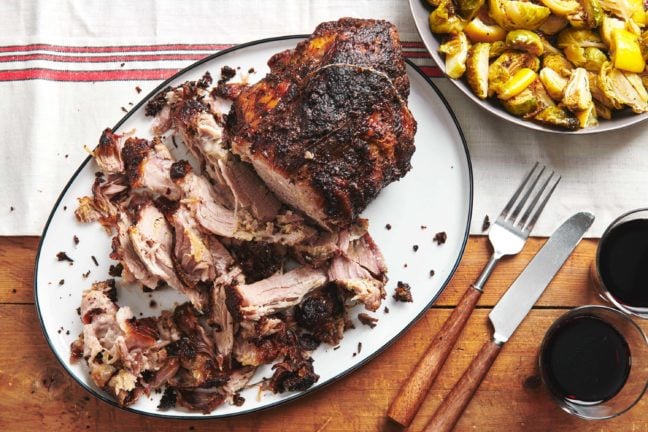
A super tender slow cooked marinated pork shoulder roast recipe that is amazing on its own, and also can be used in so many ways.
Tweet This
Low and Slow and Flexible
The flexibility of this recipe bears repeating, because it’s one of the best things about this dish. You can leave the roast in the very low oven for another hour or two or even three with no repercussions. The pork is roasted uncovered so that it gets a wonderful crusty brown exterior, while the inside becomes fall-apart tender.
If you feel like it needs a bit more browning or caramelization at the end, turn the heat up to 450°F. for 15 minutes before pulling it out of the oven. Make sure to let it rest for a bit so that the fibers can relax a bit, and the juices re-group.
And do know that if all has gone as planned, the meat will be so tender that the slices won’t hold together. That’s part of the appeal.
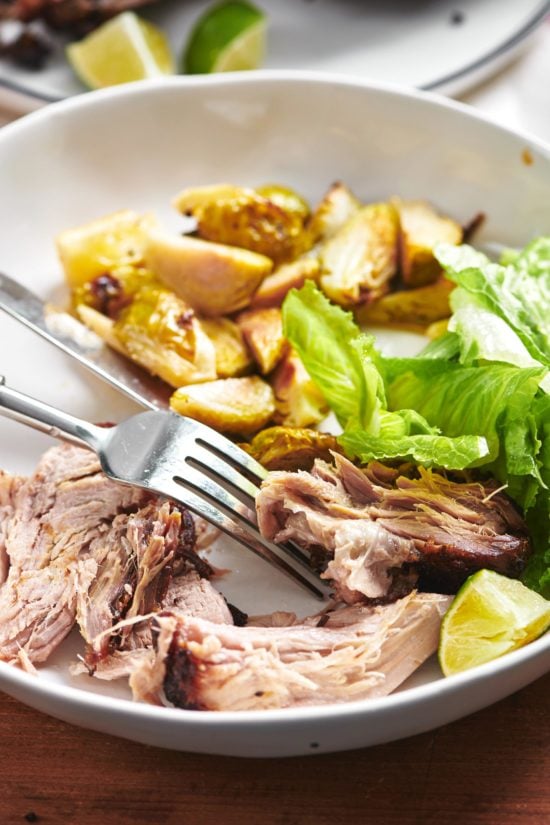
For a Smaller Pork Shoulder Roast
If your roast is smaller than 6 pounds, you can still use the recipe fully successfully, just shorten the cooking time slightly. You still want to start it at high heat, in a preheated 450°F oven. Roast the pork for 20 minutes, then turn the heat down to 250°F and continue to cook for 4 to 7 hours until the middle of the roast registers 180°F on an internal thermometer, and as you slide the thermometer in you can feel that the meat is very tender throughout.
- For a 3 pound pork roast, start with the heat at 450° for 20 minutes, then turn the heat down to 250°F and continue to cook for 4 to 5 hours until the middle of the roast registers 180°F.
- 4 pound pork roast: Start with the heat at 450° for 20 minutes, then turn the heat down to 250°F and continue to cook for 4 1/2 to 5 1/2 hours until the middle of the roast registers 180°F.
- 5 pound pork roast: Start with the heat at 450° for 20 minutes, then turn the heat down to 250°F and continue to cook for 5 1/2 to 7 hours until the middle of the roast registers 180°F.
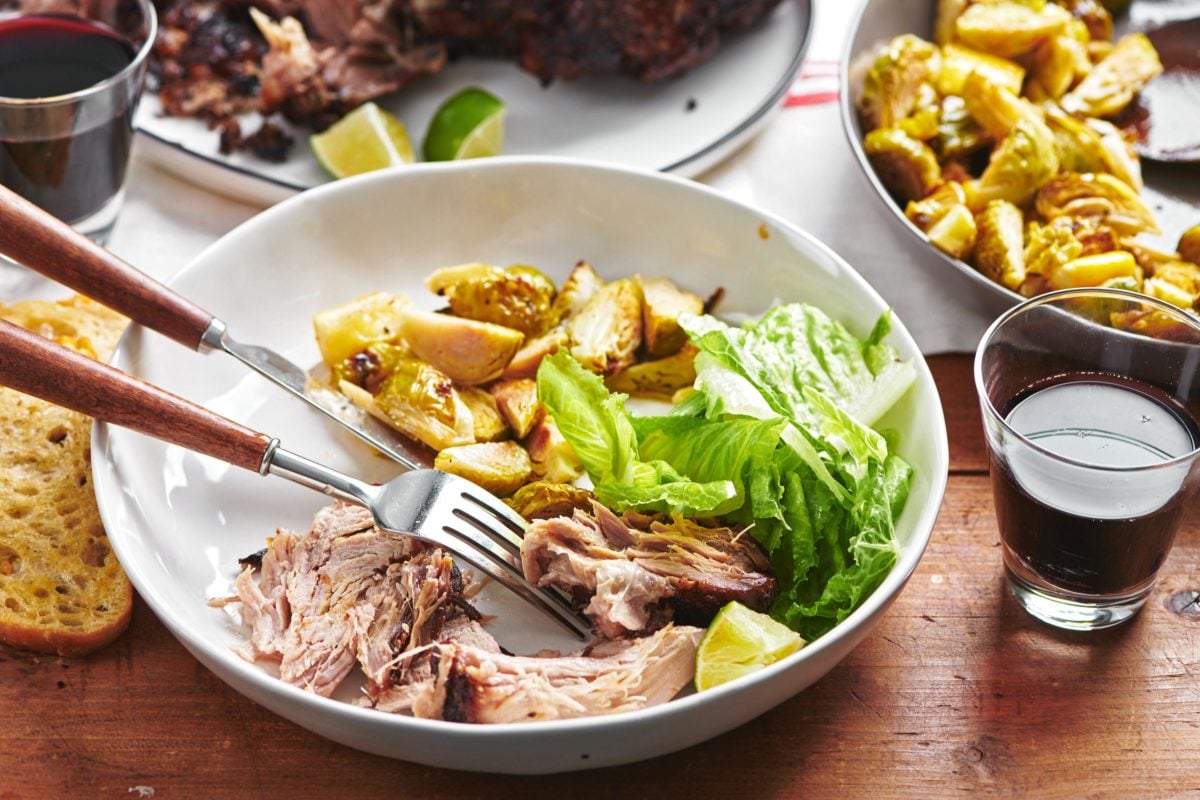
For a Larger Pork Shoulder Roast
A larger pork roast still starts with a short burst of high heat roasting, then is cooked low and slow for a longer amount of time. Again, you want the meat to be falling apart tender. Every piece or pork and every oven is different, so use the below time ranges as a guideline, start checking at the shorter end of the cooking time, and if you need to let it go longer to get tender, that’s fine. Once it begins to get tender check every 30 minutes until it is fully tender and falling apart.
For anything larger than a 6 pound roast, you will want to add another half of the marinade ingredients to the blend. If you have a 10 pound or larger roast, you’ll want to double the marinade.
- 7 pound pork roast: Start with the heat at 450° for 20 minutes, then turn the heat down to 250°F and continue to cook for 7 to 8 1/2 hours until the middle of the roast registers 180°F.
- 8 pound pork roast: Start with the heat at 450° for 20 minutes, then turn the heat down to 250°F and continue to cook for 7 1/2 to 8 1/2 hours until the middle of the roast registers 180°F.
- 9 pound pork roast: Start with the heat at 450° for 20 minutes, then turn the heat down to 250°F and continue to cook for 8 to 10 hours until the middle of the roast registers 180°F.
- 10 pound pork roast: Start with the heat at 450° for 20 minutes, then turn the heat down to 250°F and continue to cook for 8 1/2 to 10 1/2 hours until the middle of the roast registers 180°F.
Substitutions for Anchovies
I fully recommend the use of anchovies in the marinade, which don’t add any kind of strong fishy flavor, but rather a depth of overall flavor which I promise won’t taste like anchovies. If you don’t have them, or don’t want to use them, you can sub in 2 teaspoons fish sauce, 3 teaspoons minced capers, or even 2 teaspoons soy sauce.
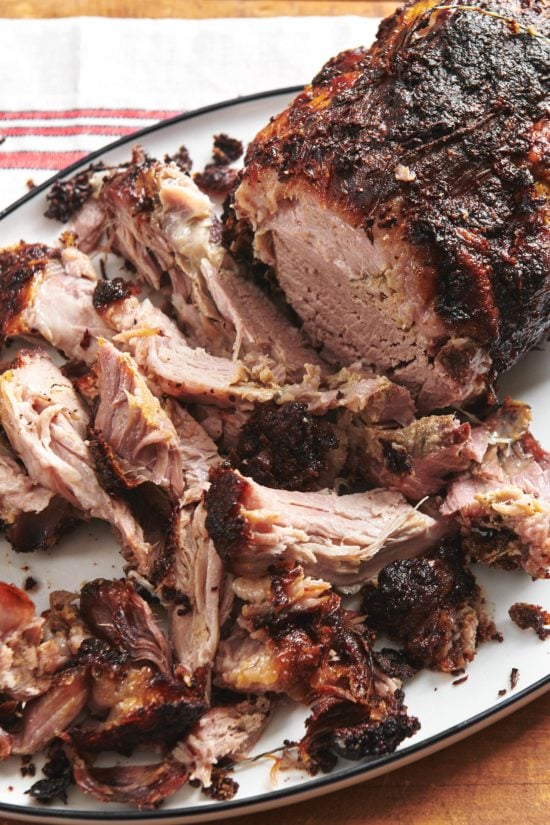
What to Serve with Pork Shoulder Roast:
Leftovers are brilliant. So endlessly useful to make amazing quesadillas, enchiladas, burritos, soups, stews, sandwiches, and so on.
Serve Fall-Apart Roasted Pork Shoulder with Rosemary, Mustard and Garlic with:
- Green Beans and Mushrooms with Shallots
- Roasted potatoes
- A green salad
- Cole slaw
- Spoonbread Corn Pudding
- Mashed Sweet Potatoes with Roasted Garlic.
- Warm Brussels Sprouts with Anchovy Vinaigrette
Other Pork Recipes:
- Pernil
- Bourbon Brown Sugar Pork Loin
- Slow Cooked Pork Roast
- Dijon and Honey Crusted Pork Tenderloins
- 2-Ingredient Slow Cooker BBQ Pulled Pork
- Slow Cooker Barbecue Pulled Pork Loin
Pin this now to find it later
Pin It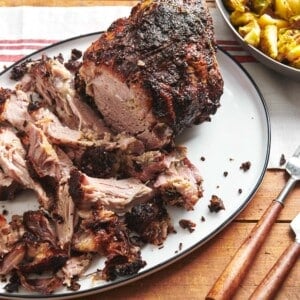
Fall-Apart Roasted Pork Shoulder with Rosemary, Mustard and Garlic
Ingredients
- 2 tablespoons chopped garlic
- 3 anchovies, rinsed
- 2 tablespoons chopped fresh rosemary
- 2 teaspoons kosher salt
- 1 teaspoon freshly ground pepper
- ¼ cup olive oil
- 2 tablespoons coarse Dijon mustard
- 1 6-pound boneless pork shoulder trimmed of excess fat and tied
Instructions
- In a small food processor combine the garlic, anchovies, rosemary, salt and pepper. Add the olive oil and process until it forms a paste, scraping down the sides. Remove the blade and use a fork or spoon to stir in the mustard. Rub the paste all over the pork shoulder, loosely cover it with plastic wrap, and refrigerate from 2 to 24 hours.
- Preheat the oven to 450°F and bring the pork to room temperature while the oven heats. Place the pork in a shallow roasting pan and roast, uncovered, for 30 minutes, until the top starts to brown a bit. Turn the heat down to 250°F and continue to cook, uncovered, for 6 to 8 hours until the middle of the roast registers 180°F. on an internal thermometer, and as you slide the thermometer in you can feel that the meat is very tender throughout. If there are juices in the pan (and I have found that sometimes there are and sometimes none) pour off the juices from the pan into a heatproof container, like a Pyrex measuring cup. Place this in the fridge, where the fat will rise to the top, while the meat rests.
- When the meat is cooked, if you think that the outside of the roast could use a bit more crust/brownness, turn the heat back up to 450°F and let it cook for another 15 to 20 minutes, to give the outside a bit more of a crunchy texture.
- Remove from the oven and let sit for about 20 minutes. Spoon the fat off the reserved juices in the fridge and pour the cooking juices into a serving pitcher or bowl (warm it a bit in the microwave or in a small pot if you like). Slice the pork as thinly or thickly as you like, knowing the meat will fall apart at least slightly. Sprinkle the sliced meat with a bit of salt before serving, and pass the pan juices on the side to drizzle over.
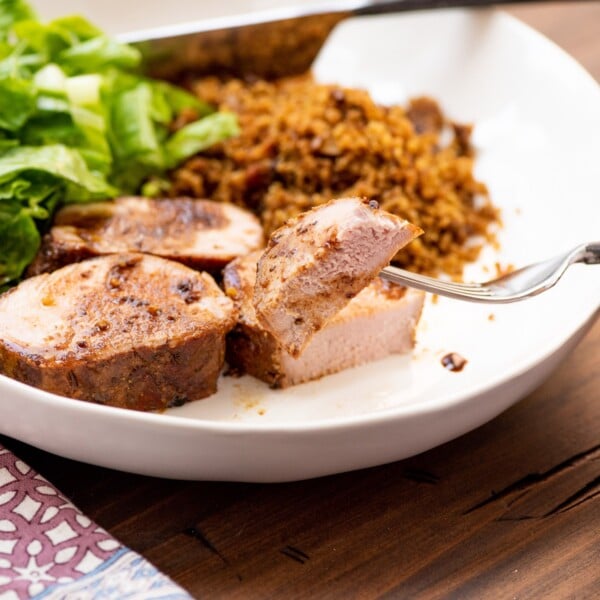
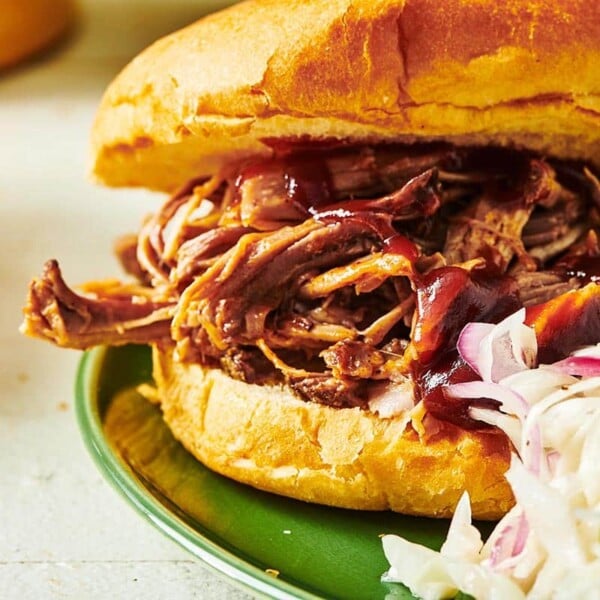
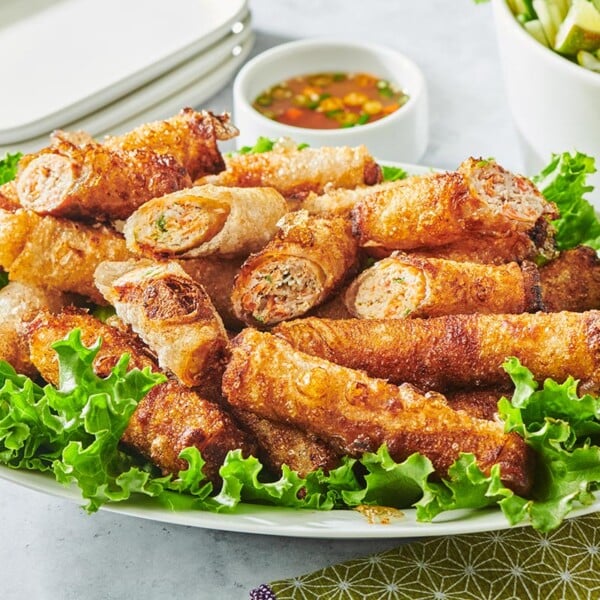
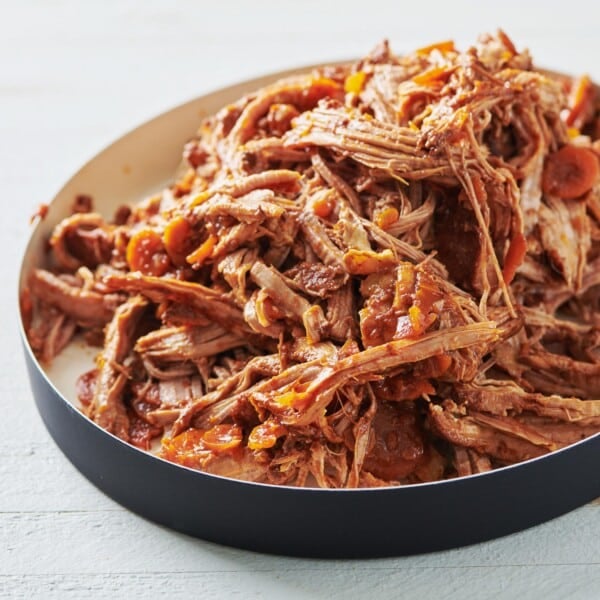









This looks and sounds amazing! I can’t wait to make it. What would you do differently with cook times if you went with bone in? I haven’t bought the roast yet but am thinking in the 6 pound range.
the cook time won’t really change, as it’s a big piece of meat, and a low and slow cooking method. Start checking at the suggested time!
Could you use this recipe for a beef roast?
I’ve never tried it, but I think it should work with a pot roast/brisket type cut, what needs low and slow cooking! If you make it, please let me know how it turns out!
roast beef is cooked at 20 minutes a pound. It will be a rock if you cook it this long
Not at 250 degrees it won’t. It’s called low and slow. Just like BBQ.
Can you do this in a crockpot? Thank you!
You can, but it will not get the out crust, which is one of the best parts of this dish – but it will become fall apart tender, and have nice flavor!
I am making this recipe now. would it work to use convection oven at 225F (i.e., 25 degrees lower to convert to convection temperature) for the same time length?
Do i need to sprinkle it with juice while cooking to prevent drying out?
Thanks.
I think lowering the temp by 25 degrees and keeping the timing similar should work! And no you don’t need to sprinkle it with juices.
Katie, thank you for this great recipe!!! It is so easy and the smell of cooking this roast is beyond description. We had someone in to make repairs in the house and he wanted to know what was in the oven and wanted to hang around for a taste. This is so good and can be used in many ways if it lasts that long. So easy to keep picking at it!! Thanks again
I hope he got a bite! So glad it was such a hit!
Absolutely delicious! Best pork roast recipe I have ever made! Thankyou!
Making this delicious roast for the second time for dinner party of 6. Cooked a 9 Lb butt roast at 250 for 12 hours and it was best pork roast I have ever eaten. So savory and tender, succulent, everyone loved it. Leftovers for hubby and I were 3 nights of enchiladas, four meals of red pozole, carnitas tacos and carnitas tortas. All from an on sale .89 cts. a lb. roast. This will be my go to for dinner parties. Thanks for this wonderful recipe.
wonderful!
2nd time making this. Have the marinade on it ( 12.5 pork butt)
In the fridge will cook Saturday or Sunday probably for 12 or so hours. Used anchovy paste couldn’t find whole anchovies but I prefer the whole anchovy. A tip if some have not thought of, use latex gloves for rubbing the marinade over the meat.
I can’t wait to try this! I need to cook a meal for 30 adults and about 6 kids. Can I cook two or three shoulder roasts at the same time?
yes, make sure they are not touching if they are the same pan, and know that you may have to add another 30 to 60 minutes of cooking time, but start checking at the recommended time.
I’ve made this once, loved it, and am making it again. I want to ask about your oven timing. The main recipe says 450 deg. for 30 minutes, then down to 250 deg. But, all your modifications for both larger or smaller weights say 450 deg. for *20* minutes, then down to 250 deg. Can you explain or account for this difference between the 20 minute vs. 30 minute start time? Thanks much. (Might be my oven, but I found the meat was done to temp much more quickly than the cook times stated.)
20 or 30 mins is the window and it shouldn’t change the overall cooking time!
Simply delicious!